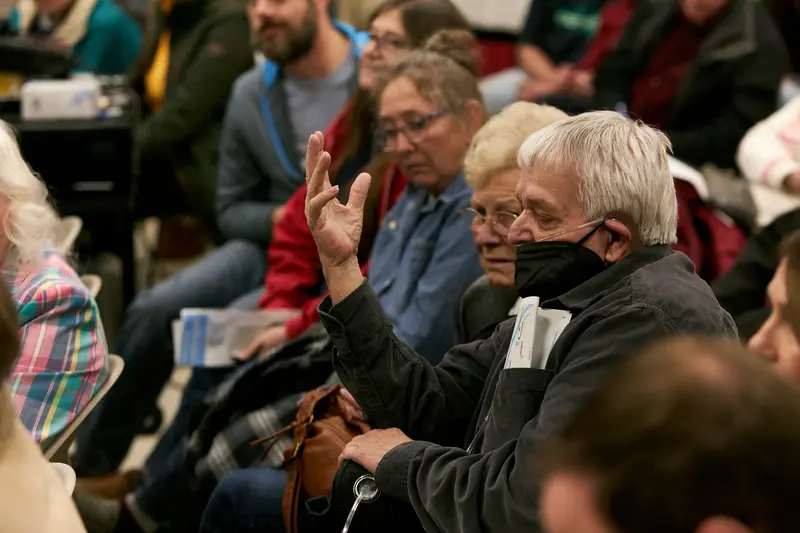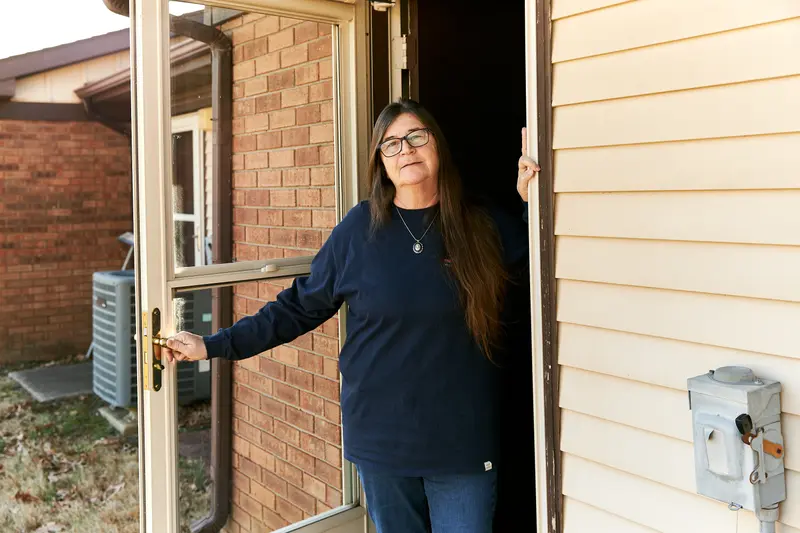The EPA Has Done Nearly Everything It Can to Clean Up This Town. It Hasn’t Worked.
The complex, contradictory and heartbreaking process of American climate migration is underway.

Nearly 100 people crowded into the library in Calvert City, Kentucky, in February when the Environmental Protection Agency hosted a public meeting on air pollution. Many had discovered flyers in their mailboxes explaining how the agency had found “elevated levels” of chemicals that “can pose an increased risk of cancer.”
The EPA aimed to deliver a simple message that evening: Local petrochemical plants were leaking toxic air pollutants and regulators were working to fix them. And what played out next was predictable to anyone who has been to one of these meetings. There were concerned questions (Would you hesitate to live here? What are you going to do today?), unsatisfying answers (We’re working with the plants on voluntary measures) and pleas for action that regulators said couldn’t happen “overnight.”
What made this meeting remarkable, however, was a sobering truth that bubbled up amid the exasperated grumbles and earnest assurances.
Once a community becomes a hot spot for these pollutants, it’s nearly impossible to clean it up for good. In fact, ProPublica found, such a success story is virtually unheard of.
In 2021, we published a cutting-edge national map of more than 1,000 communities that had become what are known as “sacrifice zones” — areas caught in clouds of cancerous pollution that seep from the refineries, chemical plants and plastic producers that power America. We highlighted all of the ways state and federal regulators had failed to protect those places, by not installing air monitors, or alerting residents, or penalizing polluters.
In Calvert City, though, all of that had already happened.
Since the early 2000s, monitors near three facilities owned by Westlake Corp. have captured alarming levels of ethylene dichloride, which is linked to stomach cancer, pancreatic cancer and leukemia. One was found emitting more of it than any other industrial facility in America.
ProPublica has written stories about the city’s problem, and the local news has followed up.
The U.S. Department of Justice has even gotten involved, forcing the company to pay a $1 million fine and spend another $110 million to fix equipment at its facilities in Calvert City and Louisiana.
None of it had stopped the poison.
Westlake didn’t respond to requests for comment. The company previously told the nonprofit newsroom Kentucky Lantern that it would work with environmental regulators and had “engaged a consultant” to study the EPA’s air-monitoring report. In response to the $1 million fine from 2022, Westlake told Law360 that it was “pleased to have reached an agreement with the United States Environmental Protection Agency and is making investments to reduce environmental emissions in concert with the company’s sustainability strategy.”

In an interview, EPA officials said they have inspected Westlake’s facilities, have updated a federal rule on industrial pollution and are working with Westlake on voluntary measures to reduce emissions in Calvert City.
“EPA is concerned about the concentrations here, and we are committed to protecting public health in this community,” said Daniel Garver, an environmental scientist in the EPA office that oversees Kentucky.
During the meeting, an older man on oxygen said he wished he’d been warned before he moved to town years ago. A woman who had never worked in a chemical plant, but had developed a rare cancer linked with industrial workers, asked the EPA to offer community cancer screenings.

And Steve Miracle, the school district superintendent, was worried about his youngest students. An air monitor near the elementary school playground had captured toxic concentrations that were many times the level that triggers EPA concern for cancer risk.
Thus far, the best fix regulators had offered were indoor air filters at the school, which would do nothing to protect the kids the moment they stepped outside.
Talking to ProPublica earlier that day, Miracle asked, “Is it going to take another two years before we get a solution in place?”
Through interviews with air pollution experts, former EPA employees and public health professionals, ProPublica found it will likely take much longer — if real change happens at all.
We asked environmental experts if they knew of communities where excess toxic air pollutants had been tamed after regulators and residents interceded.
“I don’t know of one,” said Jim Pew, an attorney at the environmental law nonprofit Earthjustice. “I think the answer is really depressing.”
The inability to stop Westlake from polluting is really an indictment of the rules that govern toxic air pollution, experts told ProPublica. Scott Throwe, a former senior EPA enforcement official, put it this way: If Westlake followed every regulation, the emissions “would still be significant.”
The EPA regulates only a handful of pollutants with enforceable standards for outdoor air quality. Air monitors track those compounds, like particulate matter and lead, and when concentrations hit a certain limit, regulators must intervene to bring them down. That might involve limiting the construction of new industrial plants or requiring emissions testing on residents’ cars.
The law governing ethylene dichloride doesn’t work like that. The EPA regulates it and 187 similar air toxics in a less direct way, by enforcing standards for the technology that polluters must install to lower emissions.
A facility like Westlake has dozens of smokestacks, tanks and other points where air toxics are supposed to be released. The company has to install pollution-control equipment on these devices to reduce emissions.
Many of them have specific emissions limits, like 2 pounds of ethylene dichloride per hour. But there’s little to no direct air monitoring to ensure the limit is met, and generally no cap on the total emissions that are allowed to come from a plant. If one of the Westlake facilities expands production and adds three smokestacks permitted at 10 pounds of ethylene dichloride per hour, it’s not required to cut back on 10 pounds in another part of the facility.
And not all air toxics come out where they’re supposed to. So-called “fugitive” emissions can escape from pumps, valves and thousands of other places. Westlake is supposed to conduct routine maintenance to identify and repair leaks. But at the end of the day, no one knows exactly how many tons of air toxics are streaming out of a particular plant.

The law has a backstop to alleviate these weaknesses: Every eight years, the EPA is supposed to review its chemical plant regulations and update them as needed. That might involve requiring newer and better pollution-control technology. Additionally, the EPA might conduct risk studies by estimating the total amount of air toxics coming from these plants and modeling how they disperse into communities. If the results show a lot of residents at high risk, that adds urgency to tightening controls.
But the agency is so understaffed that these reviews can take decades. Westlake Vinyls, one of the plants in Calvert City, got a stricter rule in April for many of its processes — the first revision since 2006.
EPA rarely conducts these reviews for industrial polluters until they’re “practically under pain of death to do it,” often due to lawsuits from environmental groups, Throwe said.
There’s ample evidence that Westlake’s emissions have gotten out of hand. The Calvert City facilities have been repeatedly fined for leaking air toxics since at least 2010. When the EPA inspected the plants in September 2022 — several months after ProPublica wrote about alarming air-monitoring results — inspectors found multiple leaks, including one estimated at 170,000 parts per million. Throwe called it a “huge” deal, considering the EPA typically counts anything above 500 parts per million as a leak. In April 2023, EPA inspectors showed up with experts from the agency’s National Enforcement Investigations Center, an elite unit whose involvement shows the case’s escalating importance. They documented additional problems in an inspection report, including a pipe with “a visible gap or hole allowing emissions to be released.”
But EPA staff are spread thin. The National Enforcement Investigations Center has five inspectors handling air-pollution violations. They’re supported by additional inspectors from other EPA offices; the one in charge of Kentucky refused to say how many air-pollution inspectors they have. (The vast majority of inspections are conducted by state and local regulators. The EPA has more of an oversight role.)
To wrap up its most recent investigation, the EPA can’t just lean on the dozen or so leaks its inspectors witnessed. If the agency wants real improvements from Westlake, it needs proof of systemic problems. It needs to examine Westlake’s records for patterns of poor maintenance and prior leaks, a labor-intensive process that could take many months.
“It is totally unacceptable” for the EPA not to act more quickly to protect the public, said Wilma Subra, an environmental health expert who advises communities on air pollution. She said the agency should know which parts of the facilities are prone to leaks based on its history and target enforcement to immediately fix those weak spots.
Once the EPA is ready to penalize Westlake, any kind of significant fine requires input from the Department of Justice, Throwe said. If the agency accepts an EPA referral, he said, negotiating a settlement with Westlake could take three to five years.
Then, whatever penalty comes out of this process would be added to the other fines the company has faced in the past.
The recent $1 million fine, for example, took eight years to levy.
The company’s net worth is $19 billion.
Residents are tired of waiting for the pollution to stop. “It’s time for EPA to really take some action,” Jim Borders, a retired credit union manager, said at the meeting, calling the government’s recent fine “chump change.”
When an EPA scientist mentioned how the agency was continuing to take air samples, a resident interrupted, “You’ve been monitoring for years!”
The updated EPA regulations for Westlake Vinyls could make a real difference, said Michael Koerber, former deputy director of EPA’s Office of Air Quality Planning and Standards. The new rule, released this month, is giving chemical plants like Westlake a two-year deadline to install ethylene dichloride air monitors along their perimeters. If concentrations exceed a certain limit, Westlake would need to investigate the cause and fix the leaks responsible for high emissions.
Koerber said the monitors could provide an early warning system and force faster repairs.
The state’s regulatory agency is working with Westlake to adopt the new regulations sooner than required, said John Mura, a spokesperson for the Kentucky Energy and Environment Cabinet. Kentucky will also apply state guidelines for cancer risk “to protect the health of Calvert City residents,” he added.
The samples merit urgent action, particularly the ones captured around the elementary school, said Koerber. The federal agency calculated that the air toxics raised chronic cancer risk to 60 in a million — meaning that if 1 million people were continuously exposed to those levels for 70 years, 60 people would likely develop cancer. That far exceeds the level that triggers EPA concern but is still below the maximum level the EPA considers acceptable.
“If I’m a parent sending my kid to this school? I’d be concerned,” Koerber said.
Children are particularly vulnerable to this kind of pollution, said Carol Ziegler, a family nurse practitioner and co-founder of the Climate, Health and Energy Equity Lab at Vanderbilt University. “Those numbers are just appalling,” she said, adding that they raise a key question: “How many sick kids are OK with you?”
Rhonda Fratzke, the woman who asked the EPA for cancer screenings, fears the pollution has caused illnesses that are difficult to diagnose. Several years ago, Fratzke learned she had angiosarcoma of the liver — a rare cancer linked to workers who handle vinyl chloride, a colorless gas used to make plastic. Fratzke lived near one of the Westlake facilities for nine years while it released vast plumes of the compound. Now, the 62-year-old just wants to see her teenage granddaughter graduate from high school. “With what time I got, I want people to know that it is your right to stand up and say, ‘Hey, just fix it.’”

Pew, the Earthjustice attorney, said regulators aren’t doing nearly enough to help communities like Calvert City. If residents want to see the best results they can get, they should look to Louisville, Kentucky, the closest experts could come to finding a partial success story. Air toxics from Rubbertown, a part of the city with a cluster of industrial plants, had affected nearby neighborhoods — largely populated by communities of color — for decades.
In 2005, local officials adopted an air toxics reduction program that was stricter than the EPA’s. Eboni Cochran, a homeschool mom and co-director of the grassroots group Rubbertown Emergency ACTion, said her organization was largely responsible for getting community support. Volunteers packed government hearings, held protests and canvassed neighborhoods to collect thousands of signed postcards urging officials to act. The group was following in the footsteps of years of activism led by the Rev. Louis Coleman Jr., who died in 2008.
Cochran said the program led to initial improvements. Even before it was fully in place, one major polluter drastically reduced its emissions, she said.
But no victory is final, Cochran added. There were years without air monitoring due to inadequate funding, and residents still complain about ineffective investigations, she said. Cochran has repeatedly sacrificed time with her husband and son to continue her advocacy.
With this kind of community work, she said, “99.9% of the time there’s no clear win.”
ProPublica is a nonprofit newsroom that investigates abuses of power. Sign up to receive our biggest stories as soon as they’re published.
ProPublica is a nonprofit newsroom that investigates abuses of power. Sign up to receive our biggest stories as soon as they’re published.







